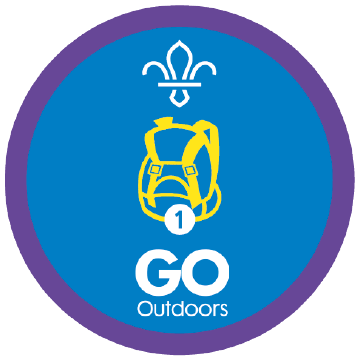Learn about pilgrimages
You’ll need
- Pens or pencils
- Scrap paper
- Map of your local area
- Device with internet access
Scouts is open to everyone. We don’t identify exclusively with one faith, and we welcome people of all faiths and of none.
We know it’s important for people to learn about each other, including understanding different faiths and beliefs. Scouts always respects people’s beliefs, faiths and cultures, and everyone should be open to learn.
As an inclusive and values based movement, we support our members to engage and learn about different faiths and beliefs in an exciting and meaningful way, even if they don’t have a faith themselves.
Celebrating and understanding differences, including differences in faiths and beliefs, is an important part of our Scout values, which are:
- Integrity: We act with integrity; we are honest, trustworthy and loyal.
- Respect: We have self-respect and respect for others.
- Care: We support others and take care of the world in which we live.
- Belief: We explore our faiths, beliefs and attitudes.
- Co-operation: We make a positive difference; we co-operate with others and make friends.
Our value of Belief and its exploration helps Scouts to learn from other faiths and beliefs. This encourages them to develop or build their personal beliefs and understand their shared values, whether faith-based on not.
We know that learning about faiths, beliefs and different attitudes can help to break down barriers, helps us all to recognise what we have in common, and teaches us to value and respect other people. It also helps us to build up respect, acceptance and knowledge for each other, leading to a more co-operative and inclusive society.
In our diverse society, people can sometimes feel cautious talking about this sensitive subject. However, it's important that Scouts offers young people safe, exciting and open spaces to explore faiths and beliefs. They should be able to engage in personal reflection, as they question and develop their opinions and understanding of the world around them.
Making time for personal reflection and developing our beliefs means exploring the places, people, communities, celebrations or stories which hold meaning for us, and it may not necessarily mean exploring a faith.
For example, someone’s shared values may be their Scout Values and that person may choose to reflect on them at important times, such as when they make their Promise. Others may choose to reflect at certain times of the year, such as a faith-based festival, birthdays, meaningful events or at New Year. Some people may still celebrate events, such as Christmas, but use it as a time to celebrate family, friends and loved ones, as well as for charity and giving.
Discover more about Faiths and Beliefs in Scouts.
A pilgrimage is a journey to a sacred place. Pilgrims usually make their journeys by foot, but sometimes people cycle, ride a horse, or complete parts of their pilgrimage on their knees. People complete pilgrimages for all sorts of reasons.
For example, the fifth pillar of Islam is the Hajj – a pilgrimage to Mecca during specific days in the last month of the Islamic calendar. The Hajj is a core practice for Muslims – they’re expected to undertake the Hajj at least once if they’re able to.
Other reasons people go on pilgrimages include to:
- Explore their faith.
- Worship and give thanks to sacred figures.
- Seek healing.
- Achieve enlightenment and gain a deeper understanding of the meaning and purpose of their lives.
- Perform an act of penance (to show they’re sorry for something they’ve done).
- Touch a holy relic to receive a blessing or miracle.
Some pilgrimages have fixed routes, modes of transport, and times you should travel. Others have multiple options, and some have no map at all – it’s all about the destination. Popular pilgrimages include:
- The birthplace of Siddhartha Gautama (the founder of Buddhism) in Nepal.
- The festival of Kumbh Mela. Once every three years, Hindus from around the world gather together to bathe in one of four holy rivers – the river changes every time.
- The Western Wall in Jerusalem. It’s a main place of pilgrimage during the festivals of Pesach, Shavuot, and Sukkot.
- The Golden Temple (or the Harmandir Sahib) in India. Around 30 million Sikhs visit every year.
- Santiago de Compostela in Spain. Catholics follow a route that leads to the shrine of St James.
Before you begin
- Use the safety checklist to help you plan and risk assess your activity. Take a look at our guidance to help you carry out your risk assessment, including examples.
- Make sure all young people and adults involved in the activity know how to take part safely.
- Make sure you’ll have enough adult helpers. You may need some parents and carers to help if you’re short on helpers.
Setting up this activity
- This activity’s all about visiting to a local place of worship or sacred space. It covers planning the visit and what to do when you’re there.
- You may want to theme this session around a pilgrimage, which is a journey undertaken for a religious motive. Although some pilgrims have wandered continuously with no fixed destination, pilgrims more commonly seek a specific place that has been sanctified by association with a divinity or other holy personage. Find out more about holy places from the British Pilgrimage Trust or sacred sites from the BBC.
- It’s up to the young people where they visit. You could choose a place of worship, such as a Gurdwara, Temple, Mosque, Church or Synagogue.
- Get in touch with the place you’re visiting in advance – find out when is convenient for you to visit, ask if it’s possible to arrange a guided tour or speak to faith leaders or members of the community, and ask if there are any rules people will need to follow.
- Take a look at our activity Interacting with faiths and cultures for more guidance.
Plan your pilgrimage
- Gather everyone in a circle and explain what a pilgrimage is.
- Explain that a pilgrimage is a journey undertaken for a religious motive. Although some pilgrims have wandered continuously with no fixed destination, pilgrims more commonly seek a specific place that has been sanctified by association with a divinity or other holy personage.
- Everyone should get into small groups of three or four people. Each group should grab some pens and paper and find a space.
- Each group should use the internet to research different places in their local community that have a religious or cultural significance.
- Once each group has a few ideas, everyone should come back together to share their ideas.
- Everyone should vote to decide which place they’d like to visit as a whole group.
- Everyone should get back into their smaller groups and research why the place is important. What faith is linked to the place? They could find out about faith leaders, traditions, or sacred texts.
- Each group should create a scavenger hunt – they should write down around 10 things another group could spot or find out when they visit their chosen place. People could think about things they’re likely to see and questions they could ask. They should remember to be respectful of the place.
- Everyone should write down any questions they’d like to ask on their visit. Did their research leave them confused about anything? Were there questions they couldn’t find the answers to?
- People should work together to plan a route from their usual meeting place to the place they’d chosen to visit. If you can, structure the route so it explores different terrains, but make sure it remains accessible to everyone. Think about green spaces, built-up spaces and different landscapes, such as woodlands and beaches, too.
Complete your visit
- If you’ve managed to arrange a tour, it may be best to do this first so everyone gets an introduction. Leave time at the end for questions.
- Get everyone to split into their groups and give each group a scavenger hunt another group made.
- Everyone should look around the location and try to complete their scavenger hunt.
- At the end of the visit, everyone should gather back together and reflect on what they’ve learned. Does anyone have any gaps in their scavenger hunt? Leave time for people to chat about any thoughts or feelings they had on the pilgrimage, if they’re comfortable sharing them.
- Each group should take a piece of scrap paper and fold it in half.
- Everyone should think about different places of worship they know about (or have visited). They should write any similarities between the places of worship and the place they’ve visited in this activity on one side of the paper, and any differences on the other side of the paper.
- People should take it in turns to share their ideas. Did any groups have ideas in common?
Reflection
This activity gave everyone the chance to think about their beliefs, values, and attitudes. Did anyone learn anything new? It might’ve been people’s first time visiting the place or interacting with the faith. Did the place look like they expected it to? If people were left with any unanswered questions, they could try to find out the answers before the next meeting.
This activity was also about being a local, national, and international citizen. Do people think that visiting new places and interacting with different people is an important part of being a citizen? At the end of the activity, everyone compared different buildings or places of worship. What were the main similarities? Global citizens try to understand the wider world and their place in it. There’s plenty of diversity and difference in the world – but are there any values or attitudes that all global citizens share? What about shared Scout values like care and cooperation?
Safety
All activities must be safely managed. You must complete a thorough risk assessment and take appropriate steps to reduce risk. Use the safety checklist to help you plan and risk assess your activity. Always get approval for the activity, and have suitable supervision and an InTouch process.
- Hiking and walking
Follow the guidance for activities in Terrain Zero, or the guidance for each the adventurous activity.
- Online safety
Supervise young people when they’re online and give them advice about staying safe. Take a look at our online safety or bullying guidance. The NSPCC offers more advice and guidance, too. If you want to know more about specific social networks and games, Childnet has information and safety tips for apps. You can also report anything that’s worried you online to the Child Exploitation and Online Protection Command. As always, if you’ve got concerns about a young person’s welfare, including their online experiences, follow the Yellow Card to make a report.
- It’s totally up to you how long or challenging your journey is. You could even build it into a weekend camp or expedition, or add some extra challenges along the route.
- To make it simpler, the person leading the activity could take charge of planning the pilgrimage a visit – the groups could just make the scavenger hunts and research.
- Make sure your route’s accessible for everyone.
- Get in touch with the place you’re visiting and ask about accessibility. Does it meet everyone’s needs? You may need to think about level access, suitable toilets, or quiet spaces where people can take a break if they need to.
All Scout activities should be inclusive and accessible.
You may be able to tick off some of the other requirements of the Scouts World Faith Activity Badge while you’re visiting.
People should be free to share anything they already know about pilgrimages if they want to. They could even help to make plans or lead discussions.

